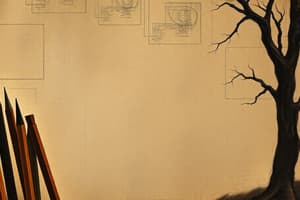Podcast
Questions and Answers
What is the minimum depth of water required around the strainer during a drafting evolution?
What is the minimum depth of water required around the strainer during a drafting evolution?
- 24 inches (correct)
- 30 inches
- 18 inches
- 12 inches
What is the role of the Unit OIC upon arrival at the scene?
What is the role of the Unit OIC upon arrival at the scene?
- To connect the drafting hose immediately
- To prepare the discharge valves for operation
- To assess the vicinity and call for a drafting evolution (correct)
- To secure all equipment in the back of the apparatus
What must be removed from the apparatus when performing a drafting operation, according to standard procedures?
What must be removed from the apparatus when performing a drafting operation, according to standard procedures?
- Hydraulic lines
- External intake valve (correct)
- Tank valve
- Drafting hose
What is the impact on pump capacity when using the BIV for drafting?
What is the impact on pump capacity when using the BIV for drafting?
When should the D/O set the apparatus to 1,000 RPMs?
When should the D/O set the apparatus to 1,000 RPMs?
What action should FFs #3 and #4 take to secure the hose connections?
What action should FFs #3 and #4 take to secure the hose connections?
How can successful priming of the pump be indicated?
How can successful priming of the pump be indicated?
What is the purpose of securing the rope from the strainer to the apparatus?
What is the purpose of securing the rope from the strainer to the apparatus?
Which factor is NOT important when selecting the drafting site?
Which factor is NOT important when selecting the drafting site?
What is the recommended time for an apparatus with a pump rating of 1,500 GPM or more to achieve a successful prime?
What is the recommended time for an apparatus with a pump rating of 1,500 GPM or more to achieve a successful prime?
What should be done if the pump is at idle and there is no indication of successful priming?
What should be done if the pump is at idle and there is no indication of successful priming?
What is required before the D/O can begin pumping water from the drafting operation?
What is required before the D/O can begin pumping water from the drafting operation?
How should the drafting hose be secured to the ladder?
How should the drafting hose be secured to the ladder?
What is the primary purpose of utilizing a flotation device when drafting from a water source?
What is the primary purpose of utilizing a flotation device when drafting from a water source?
Which equipment is essential when drafting from a well pipe?
Which equipment is essential when drafting from a well pipe?
What technique should be used to measure the well pipe's adequacy for water drafting?
What technique should be used to measure the well pipe's adequacy for water drafting?
What safety hazards should be considered when locating field wells?
What safety hazards should be considered when locating field wells?
Which of the following should NOT be done after a drafting operation is completed?
Which of the following should NOT be done after a drafting operation is completed?
What is the primary role of the Driver/Operator during a drafting operation?
What is the primary role of the Driver/Operator during a drafting operation?
When attaching the well pipe to the suction strainer, what must be ensured beforehand?
When attaching the well pipe to the suction strainer, what must be ensured beforehand?
What should be checked before dismounting from the apparatus at the drafting site?
What should be checked before dismounting from the apparatus at the drafting site?
What must firefighters do to secure the well pipe after it is lowered into the well?
What must firefighters do to secure the well pipe after it is lowered into the well?
Which factor may indicate a cavitation issue during drafting operations?
Which factor may indicate a cavitation issue during drafting operations?
What is the protocol for breaking vacuum seals after drafting operations are complete?
What is the protocol for breaking vacuum seals after drafting operations are complete?
When receiving a drafting order, what is the first action the Driver/Operator should take?
When receiving a drafting order, what is the first action the Driver/Operator should take?
What could indicate that the suction strainer is malfunctioning during drafting?
What could indicate that the suction strainer is malfunctioning during drafting?
What is the primary function of the hard suction hose in drafting operations?
What is the primary function of the hard suction hose in drafting operations?
How does a lift greater than 10 feet affect the pump's capacity during drafting?
How does a lift greater than 10 feet affect the pump's capacity during drafting?
Who has the authority to decide whether personal flotation devices should be worn?
Who has the authority to decide whether personal flotation devices should be worn?
What happens if the driver/operator exits the apparatus during drafting operations?
What happens if the driver/operator exits the apparatus during drafting operations?
What effect does the friction loss have on drafting operations?
What effect does the friction loss have on drafting operations?
Which position is referred to as the Unit Officer-in-Charge during suppression operations?
Which position is referred to as the Unit Officer-in-Charge during suppression operations?
What constitutes the lift in drafting operations?
What constitutes the lift in drafting operations?
What may Unit Officers-in-Charge (OICs) need to do regarding the standard procedures?
What may Unit Officers-in-Charge (OICs) need to do regarding the standard procedures?
Flashcards are hidden until you start studying
Study Notes
Drafting Operations Overview
- Drafting evolutions are essential when an adequate water supply is unavailable at an incident.
- Primary equipment used includes a hard suction hose and various drafting apparatus.
- The drafting operatives consist of a Unit Officer-in-Charge (OIC), Driver/Operator (D/O), and two Firefighters (FFs).
Crew Positions
- Unit OIC (#1): Officer supervising operations.
- Driver/Operator (#2): Responsible for operating the apparatus.
- Firefighter (#3): Positioned behind D/O, assists with operations.
- Firefighter (#4): Positioned behind Unit OIC, assists with operations.
Safety Procedures
- The D/O must chock wheels and engage the emergency brake before exiting the apparatus.
- Personal flotation devices (PFDs) are mandatory for non-swimmers near water.
Drafting Concepts
- Drafting is based on creating a negative pressure in the pump to draw water from a static source.
- Lift height affects capability; a lift over 10 feet decreases GPM (gallons per minute) capacity.
- Friction loss can further hinder pump performance.
Equipment Needed
- Essential drafting equipment includes roof ladders, drafting hose sections, suction strainers, rubber mallets, and supplies for securing connections.
Site Arrival and Setup
- The Unit OIC identifies a stable drafting site with at least 24 inches of water for strainer usage.
- The D/O halts the apparatus 20 feet from the drafting site for safety.
- Firefighters must check for hazards and ensure the site is operational.
Hose and Ladder Management
- The D/O closes tank and discharge valves before drafting.
- A roof ladder is used to elevate the drafting hose with the strainer submerged at least 24 inches below the surface.
Hook-Up and Priming Process
- Once hoses are connected, the Unit OIC signals the D/O to adjust location.
- Proper connection of drafting hoses is critical, including securing the strainer rope to the apparatus.
- The D/O must engage the pump after completing the hook-up.
Pumping Procedures
- The D/O sets engine RPM according to manufacturer guidelines.
- Pump priming should achieve results within 45 seconds (60 seconds for front intakes).
- Successful priming is marked by water discharge and changes in gauges.
Troubleshooting Drafting Issues
- Common issues include open valves, loose connections, and obstruction of the strainer.
- Cavitation results from air leaks or insufficient water supply.
- Overheating indicates inadequate water flow.
Completion and Shutdown Procedures
- Operations should not cease until directed by the Incident Commander (IC).
- Upon completion, the D/O must gradually idle, close discharge valves, and open drain valves to break the vacuum.
- The apparatus should backflush upon accessing municipal water supply after drafting operations.
Studying That Suits You
Use AI to generate personalized quizzes and flashcards to suit your learning preferences.




